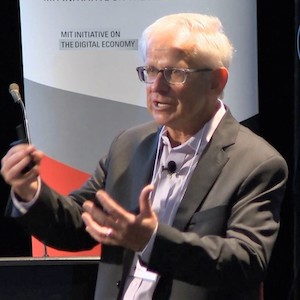 Value for customers is created differently on platforms than by traditional product/service business models. Today we’ll present and discuss the metaphor of how traditional businesses can be thought of as “pipelines” and how these pipes differ from digital platforms. This post is the first in a new series: “The New Rules of Healthcare Platforms.” We’ll be writing about platform thinking, new mental models, and the new economics of platform business models and strategy. We’ll have at least seven posts to explain these new rules. You’ll have some unlearning to do. We’ll illustrate how platform business models are fundamentally different than traditional product/service business models. To understand platforms, we need to change more than just our thinking—we need to learn new rules about how the digital world works and how platforms fit in.
Value for customers is created differently on platforms than by traditional product/service business models. Today we’ll present and discuss the metaphor of how traditional businesses can be thought of as “pipelines” and how these pipes differ from digital platforms. This post is the first in a new series: “The New Rules of Healthcare Platforms.” We’ll be writing about platform thinking, new mental models, and the new economics of platform business models and strategy. We’ll have at least seven posts to explain these new rules. You’ll have some unlearning to do. We’ll illustrate how platform business models are fundamentally different than traditional product/service business models. To understand platforms, we need to change more than just our thinking—we need to learn new rules about how the digital world works and how platforms fit in.
open ecosystem
See the following -
18 Ways To Differentiate Open Source Products From Upstream Suppliers
 Successful open source products must be able to charge a cost that is sufficient to pay for the defrayed upstream open source contributions (development costs) and the downstream productization costs (vendor costs). Stated another way, products can only charge a sufficient price if they create value that can only be captured by customers paying for them. That might sound harsh, but it's a reality for all products. There's a saying in product management: Pray to pay doesn't work. With that said, don't be too worried. There are ethical ways to capture value.
Successful open source products must be able to charge a cost that is sufficient to pay for the defrayed upstream open source contributions (development costs) and the downstream productization costs (vendor costs). Stated another way, products can only charge a sufficient price if they create value that can only be captured by customers paying for them. That might sound harsh, but it's a reality for all products. There's a saying in product management: Pray to pay doesn't work. With that said, don't be too worried. There are ethical ways to capture value.
- Login to post comments
Hart Invests in Open Source Development With Linux Foundation Gold Membership
 The Linux Foundation, the nonprofit advancing professional open source management for mass collaboration, today announced Hart has become a Gold member of The Linux Foundation. Hart develops HartOS, an API platform that allows healthcare providers and their vendors and partners to use health data from multiple computer systems in a HIPAA-compliant manner to provide rich digital experiences. These may include medical records, hospital information, radiology information, laboratory information, picture archiving, emergency department and other systems...
The Linux Foundation, the nonprofit advancing professional open source management for mass collaboration, today announced Hart has become a Gold member of The Linux Foundation. Hart develops HartOS, an API platform that allows healthcare providers and their vendors and partners to use health data from multiple computer systems in a HIPAA-compliant manner to provide rich digital experiences. These may include medical records, hospital information, radiology information, laboratory information, picture archiving, emergency department and other systems...
- Login to post comments
Here's Why Mozilla Is Building A $US25 Smartphone
Last week, Mozilla tapped Andreas Gal as its new chief technology officer...He’s intensely focused on Firefox OS, a mobile operating system with big ambitions: winning the battle for the next two billion smartphone users...
- Login to post comments
How Are Open Source And Cloud Computing Compatible?
 It seems everyone is rushing to get their software on the cloud. The rapid growth of cloud computing has empowered hyperscaler cloud providers to market various technologies to feed the growing demand. Hyperscalers are now providing full-stack capabilities to increase their footprint and further lock-in customers, making the cloud seem more like a threat than an open communal space. What does the cloud actually offer? Quite a lot, based on reports from the field:
It seems everyone is rushing to get their software on the cloud. The rapid growth of cloud computing has empowered hyperscaler cloud providers to market various technologies to feed the growing demand. Hyperscalers are now providing full-stack capabilities to increase their footprint and further lock-in customers, making the cloud seem more like a threat than an open communal space. What does the cloud actually offer? Quite a lot, based on reports from the field:
- Login to post comments
Lessons from the Use of Open Source and Open Data in Nepal's Earthquake Relief
 The power of an open source project like OpenStreetMap during a crisis like Nepal's earthquake is undeniable, and I had the opportunity to see it up close and personal. I worked with the Kathmandu Living Labs team, where I observed thousands of local and international volunteers collaborating to create data and tools. Responding agencies used the team's work to plan and execute their operations. The philosophy of Kathmandu Living Labs is that by collaboratively building upon existing work, we will reach much further and have a far greater impact than working on problems individually and from scratch...
The power of an open source project like OpenStreetMap during a crisis like Nepal's earthquake is undeniable, and I had the opportunity to see it up close and personal. I worked with the Kathmandu Living Labs team, where I observed thousands of local and international volunteers collaborating to create data and tools. Responding agencies used the team's work to plan and execute their operations. The philosophy of Kathmandu Living Labs is that by collaboratively building upon existing work, we will reach much further and have a far greater impact than working on problems individually and from scratch...
- Login to post comments
Lessons Learned for Building an Open Company with Transparent Collaboration
 In the first part of this two-part series, Building a business on a solid open source model, I described how an open source business needs to provide a solid ground for all stakeholders, users, contributors, employees, customers, and of course investors. Foundations, licenses, and trademarks can be helpful in building an open ecosystem. Open source communities need supporting organizations to work transparently, otherwise there are barriers to contribution. Code might be public, but code dumps (like Google tends to do with Android) don't always facilitate collaboration. To encourage collaboration, you must go one step further and be proactive...
In the first part of this two-part series, Building a business on a solid open source model, I described how an open source business needs to provide a solid ground for all stakeholders, users, contributors, employees, customers, and of course investors. Foundations, licenses, and trademarks can be helpful in building an open ecosystem. Open source communities need supporting organizations to work transparently, otherwise there are barriers to contribution. Code might be public, but code dumps (like Google tends to do with Android) don't always facilitate collaboration. To encourage collaboration, you must go one step further and be proactive...
- Login to post comments
OpenMRS & OpenEMR Community Members Join Forces - Announce LibreHealth
 Senior contributors and leaders from OpenMRS & OpenEMR, the two leading open source Health IT platforms, have announced the formation of LibreHealth, a new initiative to expand on many years of work by those communities’ volunteers through increased focused on needs of its users in critical areas. After many years of growth under the sponsorship of organizations OEMR & OpenMRS Inc., key members of the two communities have joined forces to launch a successor free & open source software community to fulfill their vision of improved health outcomes around the world.
Senior contributors and leaders from OpenMRS & OpenEMR, the two leading open source Health IT platforms, have announced the formation of LibreHealth, a new initiative to expand on many years of work by those communities’ volunteers through increased focused on needs of its users in critical areas. After many years of growth under the sponsorship of organizations OEMR & OpenMRS Inc., key members of the two communities have joined forces to launch a successor free & open source software community to fulfill their vision of improved health outcomes around the world.
OSEHRA 2017: Microsoft, OpenStack, IBM Support VistA in the Cloud
 This year’s OSEHRA 2017 Open Source Summit proved to be another major milestone in the transition from locked-in vendor-controlled health information technology to an open solutions approach. One of the major news stories at the summit was the decision by Microsoft to join OSEHRA and collaborate with the Open Health community. Another major presentation was that of Martin Rice, Director of the Division of State System for the Centers for Medicare and Medicaid Services (CMS) and Clyneice Chaney, Principal Systems Engineer. In their presentation (video* and PowerPoint*), Rice and Chaney described how CMS is transitioning to an open/modular approach to State Medicaid IT systems.
This year’s OSEHRA 2017 Open Source Summit proved to be another major milestone in the transition from locked-in vendor-controlled health information technology to an open solutions approach. One of the major news stories at the summit was the decision by Microsoft to join OSEHRA and collaborate with the Open Health community. Another major presentation was that of Martin Rice, Director of the Division of State System for the Centers for Medicare and Medicaid Services (CMS) and Clyneice Chaney, Principal Systems Engineer. In their presentation (video* and PowerPoint*), Rice and Chaney described how CMS is transitioning to an open/modular approach to State Medicaid IT systems.
- Login to post comments
The New Rules of Healthcare Platforms (Part 1): Value Creation Shifts from Pipes to Platforms
- Login to post comments
VistA for the NHS
So in conclusion I have a different vision for VistA in the NHS than the NHS Campaign for VistA. However, we both want to see an NHS version of VistA and we both want to see it widely implemented. So let not worry about where we hope and think this should lead. Looking at the NHS Campaign for VistA’s 8 point plan http://nhsvista.net/our-ambition/ The first six steps align broadly with what I want to see happen so lets get on an do it and see where it leads us which I suspect might be a different than any of us currently expect.
Read More »
- Login to post comments
‘Open Source, Open Science’ meeting report – March 2015
 On March 19th and 20th, the Center for Open Science hosted a small meeting in Charlottesville, VA, convened by COS and co-organized by Kaitlin Thaney (Mozilla Science Lab) and Titus Brown (UC Davis). People working across the open science ecosystem attended, including publishers, infrastructure non-profits, public policy experts, community builders, and academics. Read More »
On March 19th and 20th, the Center for Open Science hosted a small meeting in Charlottesville, VA, convened by COS and co-organized by Kaitlin Thaney (Mozilla Science Lab) and Titus Brown (UC Davis). People working across the open science ecosystem attended, including publishers, infrastructure non-profits, public policy experts, community builders, and academics. Read More »
- Login to post comments
openEHR and FHIR – Fiends or Foes? - HIGHmed Symposium 2021
Ever since the COVID-19 pandemic, the need for interoperable and scalable data infrastructures within healthcare has become even more apparent. National and regional governments address these challenges by introducing open platforms, a novel paradigm to enable the data flow required to harness the full potential of big data in medicine. To underline the importance of open platforms, and to provide examples of novel implementations to political stakeholders and the health IT community, we dedicate our this year’s HiGHmed Symposium to openEHR and FHIR, the underlying eHealth standards of the data environment of tomorrow.
- Login to post comments
